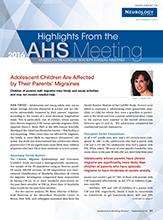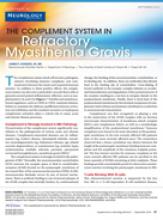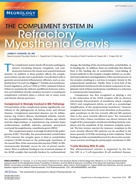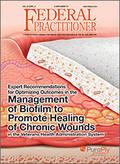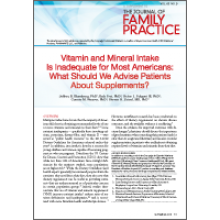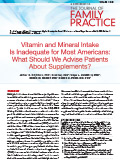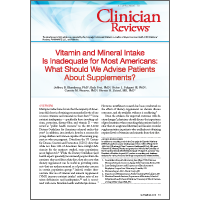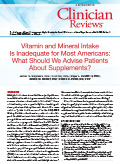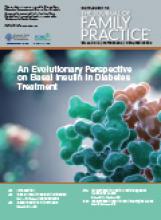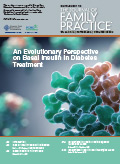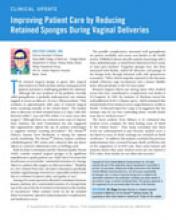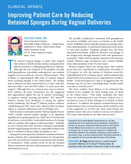User login
Highlights From the 2016 ECTRIMS Meeting
Abstracts Presented at the 2016 AVAHO Annual Meeting
Highlights From the 2016 AHS Meeting
Click here to download the digital edition.
Click here to download the digital edition.
Click here to download the digital edition.
The Complement System in Refractory Myasthenia Gravis
Click here to read the supplement.
Click here to read the supplement.
Click here to read the supplement.
Expert Recommendations for Optimizing Outcomes in the Management Of Biofilm to Promote Healing of Chronic Wounds in the Veterans Health Administration System
A supplement to Federal Practitioner. This supplement is sponsored by Organogenesis, Inc.
Chronic non-healing wounds are a major problem for patients and wound care practitioners in the VA system. It is self-evident among experienced wound care practitioners that wound infection can delay (or completely prevent) wound healing. Biofilm is a common form of wound contamination that is now recognized to be a major factor in delaying the healing of wounds.
This supplement discusses the awareness of the biology of biofilm, its prevalence, its clinical significance, and optimal treatment approaches that need to be improved. The supplement also reviews the current status of evidence-based management of biofilm with a focus on the optimal use of PuraPly™ Antimicrobial, a native purified collagen matrix containing the antimicrobial polyhexamethylene biguanide (PHMB).
| Meeting Participants |
Gregory Shultz, PhD |
Stephen C. Davis |
Jonathan N. Brantley, DPM |
Mark Couture, DPM |
Sean L. Kersh, DPM |
Jake G. Ruff, DPM |
Patrick J. Sanchez, DPM |
Janette Thompson, DPM |
Catherine M. Wittgen, MD |
| CLICK HERE TO READ FULL SUPPLEMENT |
A supplement to Federal Practitioner. This supplement is sponsored by Organogenesis, Inc.
Chronic non-healing wounds are a major problem for patients and wound care practitioners in the VA system. It is self-evident among experienced wound care practitioners that wound infection can delay (or completely prevent) wound healing. Biofilm is a common form of wound contamination that is now recognized to be a major factor in delaying the healing of wounds.
This supplement discusses the awareness of the biology of biofilm, its prevalence, its clinical significance, and optimal treatment approaches that need to be improved. The supplement also reviews the current status of evidence-based management of biofilm with a focus on the optimal use of PuraPly™ Antimicrobial, a native purified collagen matrix containing the antimicrobial polyhexamethylene biguanide (PHMB).
| Meeting Participants |
Gregory Shultz, PhD |
Stephen C. Davis |
Jonathan N. Brantley, DPM |
Mark Couture, DPM |
Sean L. Kersh, DPM |
Jake G. Ruff, DPM |
Patrick J. Sanchez, DPM |
Janette Thompson, DPM |
Catherine M. Wittgen, MD |
| CLICK HERE TO READ FULL SUPPLEMENT |
A supplement to Federal Practitioner. This supplement is sponsored by Organogenesis, Inc.
Chronic non-healing wounds are a major problem for patients and wound care practitioners in the VA system. It is self-evident among experienced wound care practitioners that wound infection can delay (or completely prevent) wound healing. Biofilm is a common form of wound contamination that is now recognized to be a major factor in delaying the healing of wounds.
This supplement discusses the awareness of the biology of biofilm, its prevalence, its clinical significance, and optimal treatment approaches that need to be improved. The supplement also reviews the current status of evidence-based management of biofilm with a focus on the optimal use of PuraPly™ Antimicrobial, a native purified collagen matrix containing the antimicrobial polyhexamethylene biguanide (PHMB).
| Meeting Participants |
Gregory Shultz, PhD |
Stephen C. Davis |
Jonathan N. Brantley, DPM |
Mark Couture, DPM |
Sean L. Kersh, DPM |
Jake G. Ruff, DPM |
Patrick J. Sanchez, DPM |
Janette Thompson, DPM |
Catherine M. Wittgen, MD |
| CLICK HERE TO READ FULL SUPPLEMENT |
Vitamin and Mineral Intake Is Inadequate for Most Americans: What Should We Advise Patients About Supplements?
This supplement examines the role of vitamin and mineral supplements in increasing nutrient intake and reducing nutrient deficiencies and inadequacies. Although research is needed to study the effects of dietary supplements on chronic disease outcomes, US health care providers need to know how to advise their patients about adding vitamins and minerals to their diets.
This supplement examines the role of vitamin and mineral supplements in increasing nutrient intake and reducing nutrient deficiencies and inadequacies. Although research is needed to study the effects of dietary supplements on chronic disease outcomes, US health care providers need to know how to advise their patients about adding vitamins and minerals to their diets.
This supplement examines the role of vitamin and mineral supplements in increasing nutrient intake and reducing nutrient deficiencies and inadequacies. Although research is needed to study the effects of dietary supplements on chronic disease outcomes, US health care providers need to know how to advise their patients about adding vitamins and minerals to their diets.
Intake of Vitamins and Minerals Is Inadequate for Most Americans: What Should We Advise Patients About Supplements?
An Evolutionary Perspective on Basal Insulin in Diabetes Treatment
- Role of Insulin Therapy in Diabetes
- Basal Insulin in Primary Care
- Innovations in Insulin: Insulin Degludec U-100 and U-200
- Innovations in Insulin: Insulin Glargine U-300
- Role of Insulin Therapy in Diabetes
- Basal Insulin in Primary Care
- Innovations in Insulin: Insulin Degludec U-100 and U-200
- Innovations in Insulin: Insulin Glargine U-300
- Role of Insulin Therapy in Diabetes
- Basal Insulin in Primary Care
- Innovations in Insulin: Insulin Degludec U-100 and U-200
- Innovations in Insulin: Insulin Glargine U-300
Clinical Update: Improving Patient Care by Reducing Retained Sponges During Vaginal Deliveries
This supplement is sponsored by Medtronic.
The retained surgical sponge or gauze after surgical intervention or a birth can have serious consequences for patients and poses a challenging problem for clinicians. This supplement explores the causes and consequences of sponge retention and how the Situate™ Delivery System can help reduce the incidence of gossypiboma, which is responsible for approximately 2000 cases of retained surgical items each year in the US.
Hector Chapa, MD
Clinical Assistant Professor
Texas A&M College of Medicine – College Station
Department of ObGyn, Brazos Valley ObGyn
ObGyn Hospitalist Group
CHI St. Joseph Regional Hospital
Bryan, Texas
Click here to read the Clinical Update
This supplement is sponsored by Medtronic.
The retained surgical sponge or gauze after surgical intervention or a birth can have serious consequences for patients and poses a challenging problem for clinicians. This supplement explores the causes and consequences of sponge retention and how the Situate™ Delivery System can help reduce the incidence of gossypiboma, which is responsible for approximately 2000 cases of retained surgical items each year in the US.
Hector Chapa, MD
Clinical Assistant Professor
Texas A&M College of Medicine – College Station
Department of ObGyn, Brazos Valley ObGyn
ObGyn Hospitalist Group
CHI St. Joseph Regional Hospital
Bryan, Texas
Click here to read the Clinical Update
This supplement is sponsored by Medtronic.
The retained surgical sponge or gauze after surgical intervention or a birth can have serious consequences for patients and poses a challenging problem for clinicians. This supplement explores the causes and consequences of sponge retention and how the Situate™ Delivery System can help reduce the incidence of gossypiboma, which is responsible for approximately 2000 cases of retained surgical items each year in the US.
Hector Chapa, MD
Clinical Assistant Professor
Texas A&M College of Medicine – College Station
Department of ObGyn, Brazos Valley ObGyn
ObGyn Hospitalist Group
CHI St. Joseph Regional Hospital
Bryan, Texas
Click here to read the Clinical Update




